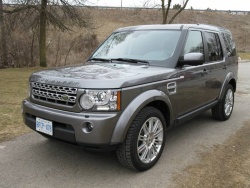 2010 Land Rover LR4. Click image to enlarge |
| Manufacturer’s web site Land Rover Canada |
Review and photos by Jil McIntosh
Find this vehicle in Autos’s Classified Ads
Photo Gallery:
2010 Land Rover LR4
I’ve never been to the United Kingdom, but I’ve seen enough television episodes of Doc Martin and Father Ted to have formed my stereotype: stiff-upper-lipped gentlemen with caps and shotguns, heading out across the moors with their hounds. This requires them to drive a vehicle capable of climbing the white cliffs of Dover, while providing luxury just a few rungs south of what you might expect from Mr. Rolls and Mr. Royce.
This is how I’m trying to figure out Land Rover, and specifically, my LR4 tester. It has a dial for the off-road that I can spin for everything from sand dunes and mud, to climbing over boulders. It has video screens in the back of the head restraints. It has leather seats, and all-around cameras, and a price tag of $77,720. While it’s a very nice and extremely competent vehicle for all that, given that I don’t see too many people in my area heading off to explore their rock-and-heather estates, I have to wonder where its market is. I can’t be alone on that: the company seldom sells more than 200 vehicles a month, including all model lines, for all of Canada. It is, sadly, like many of its SUV brethren: able to leap tall trails at a single bound, but who would ever take a vehicle that expensive anywhere that it might get a scratch on its paint or stones in its tires?
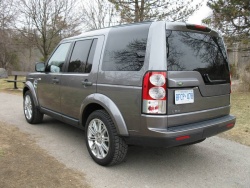 2010 Land Rover LR4. Click image to enlarge |
Known as the Discovery 4 across the pond, the LR4 is the 2010 evolution of the 2009 LR3. Style-wise, changes include a new grille and lights, including new LEDs, and an updated interior. Chassis tuning and tweaking to the Terrain Response system give it improved handling and off-road ability.
The big change, though, is under the hood. Where the LR3 offered a 4.0-litre V6 or 4.4-litre V8, the 2010 edition comes with a single powerplant: a new 5.0-litre direct-injection V8 that makes matching numbers of 375 horsepower and 375 lb-ft of torque, mated to a six-speed automatic transmission. That’s quite a hike over the previous V8’s figures of 300 horses and 315 lb-ft of torque, but published fuel numbers are virtually the same. That’s even more surprising, given that the LR4 has packed on some serious poundage: while the V8-powered LR3 weighed in at 2,461 kg (5,425 lbs), the LR4 beefs up to 2,646 kg (5,833 lbs) (must be too many deep-fried Mars bars after dinner.)
The new V8 is rated at 17.1 L/100 km (17 mpg Imp) in the city, and 11.6 L/100 km (24) when roaming the countryside. In combined driving, I averaged 17.2 L/100 km (17).
I never had a chance to drive the LR3; indeed, this marks my first time behind a Land Rover’s steering wheel. It’s astonishing that something this heavy can move out this fast. It goes like stink right off the line, and its powerband is fat enough to keep it pulling hard pretty much anywhere on the throttle.
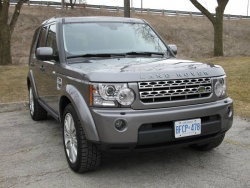 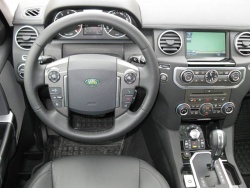 2010 Land Rover LR4. Click image to enlarge |
It starts at $59,900, which gets you the base model with seating for five. Moving up to the $3,750 HSE Package adds numerous items, including a front parking sensor to complement the rear one on the base model, heated steering wheel, and a navigation system. You need at least the HSE package in order to add the optional third row of seats, which bumps the HSE-plus-seats package to $6,250. The HSE LUX is seven-seater only, for an additional $10,800, while a LUX Plus adds a surround-view camera, for $12,690. Other available options include roof rails, rear-seat entertainment system, a heavy-duty package with active locking rear differential, and the surround camera system as a stand-alone option at $990.
The camera system is primarily meant for off-road driving, although it can come in handy in tight parking lots. It consists of five cameras: one in each exterior mirror, two in the front bumper, and one in the rear. The views show up in the navigation system screen, and different views can be selected, including watching all at once. What’s very odd is that, while I expected to be able to watch them during very low-speed driving where they’d warn of rocks or obstacles on an off-road trail, these displays will continue to run until you turn them off, regardless of speed. I could watch a “movie” of the various views while doing 100 km/h on the highway, which I should think would be considered a distraction. Very usefully, the cameras also mean you can see exactly what you’re doing when you’re hitching up or backing up a trailer.
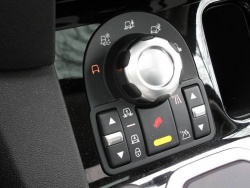 2010 Land Rover LR4. Click image to enlarge |
You could be forgiven for thinking that the Terrain Response off-road mode dial on the console is a fake: this SUV rides nothing like what you’d expect from a serious trail machine. It’s like a big luxury sedan, and handles like it, too. Going around corners, there’s little clue as to its height, as body lean is very well-controlled. Its weight doesn’t overpower the brakes, with the pedal providing nice bite early in the travel, and everything stopping straight and securely.
The LR4 is always in four-wheel drive; the programs on the Terrain Response dial control the degree of input from the engine, transmission and stability control functions, and in some settings, the differential and suspension. “General” is used for on-road driving. From there, you can choose Grass-Gravel-Snow, Mud-Ruts, Sand, or Rock Crawl, which activates only in low gear. The driver-adjustable air suspension will rise 55 mm above normal height for off-road, or drop 50 mm for “access” height, allowing easier entry and exit. At very low speeds, the vehicle can remain lowered, which might be helpful when that last little bit will squeeze you under the garage door, but at regular road speeds, the vehicle automatically returns to normal height if it was propped up too high or dropped too low. At its highest, the LR4 can wade through 700 mm of water, and the speed of its hill descent control can be adjusted by tapping the cruise control buttons.
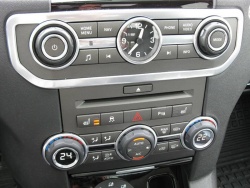 2010 Land Rover LR4. Click image to enlarge |
It’s generally been my experience that the more expensive the vehicle, particularly in an all-wheel SUV, the more difficult it will be to figure out the controls (Audi, are you listening?). The LR4 isn’t; instead, it’s refreshingly intuitive and easy. You want to turn the stereo on, you hit the big button, and then you spin that to turn up the sound. If you don’t want your climate control on automatic, you simply press one of the three mode buttons, without a need to find the icons on a computer screen. Then – and this is brilliant – if your windshield suddenly fogs up, you hit a single button that puts everything on maximum defrost. When it’s done, you hit that button again to turn it off, and your HVAC goes back to whatever setting you had before.
What I didn’t like, though, was the heated windshield. I’m sure it’s great for taking off the ice (it never got cold enough for me to test it), but it does this via tiny, closely-spaced wires that run vertically in the glass. I found myself straining to look through them, rather than at them, especially in bright sunlight when they were particularly visible. It’s similar to looking through a screen door, and my husband said it gave him a headache.
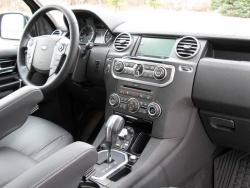 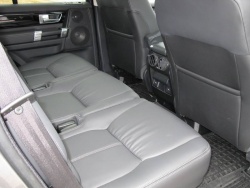 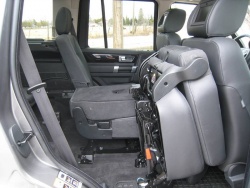 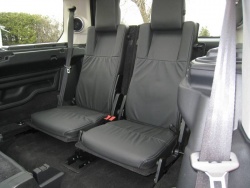 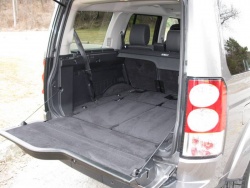 2010 Land Rover LR4. Click image to enlarge |
The LR4’s seats are firm but supportive, and clad in luscious leather that, courtesy of the Premium Leather Package included in the HSE LUX package, also puts that upper-level cowhide on the steering wheel, shifter knob and cubby box lid. Open that, and inside, you’ll find a cooler box that’s a true on-off refrigerated unit, not just an a/c vent routed into it. A USB and auxiliary input outlet are found just above it.
The second-row seats fold and tumble forward for access to the optional third row. Deploying the two third-row seats involves climbing into the vehicle to release the seatbacks and pull them upright. The third-row cushions are flat and I don’t know how long I’d want to sit on them, but the legroom is incredible: unlike most three-row vehicles, real adults can actually fit back there, especially since the high-mounted second-row chairs have enough room for slipping feet under them. The LR4’s square shape also ensures plenty of headroom, and three huge sunroof panels ensure light and airiness right to the back.
With the third- and second-row seats folded, there’s a completely flat cargo floor. The asymmetrical tailgate opens clamshell-style: you first pop open the top half, and then press a rubber-covered power switch (it takes more pressure than expected, and you have to hit exactly the right spot) to open the bottom half. A small panel slides across the tailgate opening to provide a flat surface for sliding goods into the vehicle.
Ford never seemed to be sure what to do with Land Rover; perhaps its new owner, India’s Tata, might have a vision of how to improve the brand’s visibility in North America. With its upgrades and better interior, the LR4 might be poised to grab buyers who always wanted a Range Rover, a lovely vehicle but one that’s almost $34,000 more. Or those who only ever stay on solid dry asphalt, but picture themselves in tweeds and wellies, off to explore the vast uncharted corners of their English estates.
|
Pricing: 2010 Land Rover LR4
Click here for options, dealer invoice prices and factory incentives
Specifications
Competitors
Crash test results
|







 Follow Autos on Twitter
Follow Autos on Twitter



